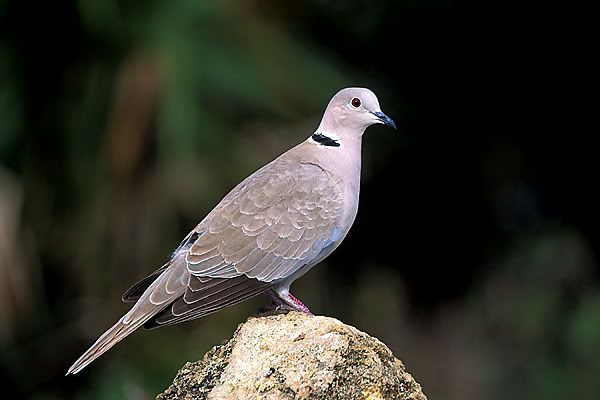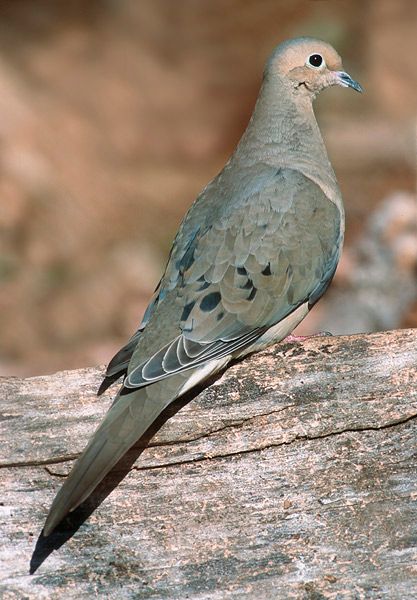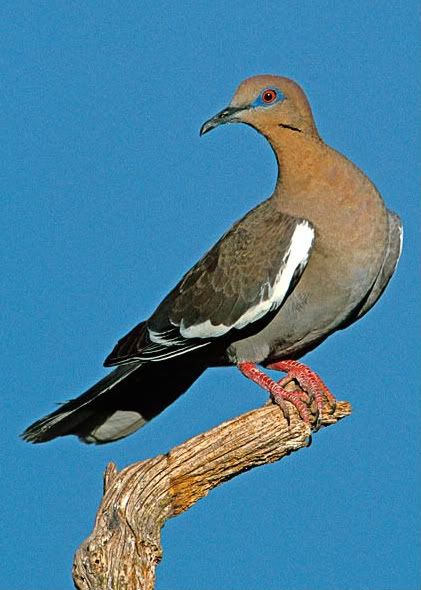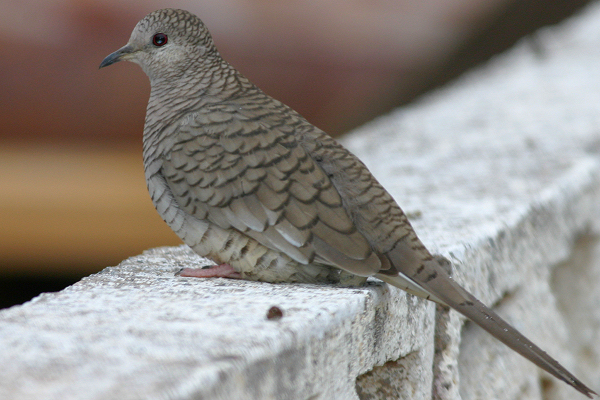Here in the high desert of Central Oregon we are flooded with them both in town and out in the sticks. Here, they are an unprotected species (something like collared Asian dove)and it is open season on them. They are a bit larger than the Mourning dove and seem to act a lot like quail in foraging. They are much more numerous than Mourning doves ever were in this area. Sounds like they might be fun. How numerous are they in the rest of the country?
They have come into Illinois and Missouri in fair but not large numbers over the last 5 or so years. They seem to prefer the city life to the country life here and I see more in my yard than afield. I call them Eurasian collared doves. I hope they flood in here too and give some wingshooting opportunity. Not enough yet though.
If you are talking about the Eurasian Collared Dove, they were not "introduced" so much as they migrated, but they are everywhere in the southwest. Never saw one until about ten years ago, and now there are reports of guys shooting 100 birds in a day. Somewhat unlike mourning doves and whitewings, the Eurasians seem to congregate in town and around habitated areas. Even out in the country, the Eurasions will be sitting in the trees and on the lines around farmhouses, while the mournings and whitewings will be roosting in the orchards and along the river banks. There is some speculation that they are interbreeding with other doves, and the two game wardens that I have discussed this with said that the "collar" on the neck will be the deciding factor if there is any question about whether you have a game or non-game bird in your vest. There is a lot of meat on these birds and they taste just like any other dove. Good burritos. If you can find them, they are relatively easy to shoot because of their slow, straight flight. Like pigeons, if you shoot and miss, they will often circle back to get to their favorite roost.
I saw the first ones here in Nebraska about 6 years ago. I had never heard of them, but the fellow whose yard they flew into knew what they were. Same story, they like town and buildings better than out in the country. My grandson and I were dove hunting in the sandhills of Nebraska this fall, and he shot two in a single shot. They are about half again as big as a mourning dove.
If the regulations are still in effect, the season is from January 1 through December 31. There are getting to be more and more of them.
Sam Ogle, Lincoln, NE
Large numbers in the Texas Panhandle. But, as mentioned, they are primarily a town bird but some do travel out to nearby fields to feed. They can take a lot of lead and I have been having great success using #6 shot.
My take on the collared doves is that eventually they will become a big time agricultural pest in North America, and a maybe like it was when I lived in South Africa--farmers will furnish shot shell if the dove shooters will come and shoot Rock pigeons and doves in his fields.
Bv
Plenty of them in Arizona, have to ping them with BB gun to keep them off my bird feeders. I think they are pushing out the mourning doves and pigeons too. I have eaten a few of them, same as the other doves. The season is year round with no limit. We have welcome mats out with some of the dairy farmers around here, for those of us they know, to shoot Collared and Pigeons anytime. No question they will be a blight on agriculture soon. Easier to hit than Mourning Doves with slower flight and few evasive maneuvers.
I have been reluctant to shoot them because they seem to be such an "innocent" bird. I know it's dumb. Just my take on them.
JR
My experience is that they are bigger by about 30-50% and the meat is slightly lighter as well as being milder flavored. A much better eating meat.
eurasian

mourning

white wing

Inca

For a complete list...
http://www.diamonddove.info/bird15%20NA%20Doves.htmPete
Here they have the same season and are counted in the limit in aggregate with mourning doves. Can't tell them apart on the wing anyway.
Here they have the same season and are counted in the limit in aggregate with mourning doves.
Virginian if you leave the wing and head on there is no bag limit on Eurasian dove:
http://www.wlf.louisiana.gov/hunting/dove"but note: there is no bag limit on Eurasian collared-doves or ringed turtle-doves provided that a fully feathered wing and head remain attached to the carcass of the bird."
We see alot of them around them peanut mills. They do like civilization.
Adam
I can recall seeing my first one in the early 60's here in England when I was a kid. I checked all my bird books but couldn't find it. By the early 70's they were fairly common and soon put on the pest lists. They had spread in from continental Europe by natural means. They are not a great problem and I only shoot them round farm buildings if asked to do so. They are fine to eat. It's amazing how fast they spread but then they seem to find a natural limit. Lagopus.....
They have the square tail of a pigeon and their primaries don't whistle as much as a Mourning Dove's do. Their call is much lower than their cousin's, almost comically so. As stated here previously, they eat just fine. In Colorado they are considered an invasive species. I have heard that they will ultimately inhabit the same ecological niche as the Passenger Pigeon once did here.
Had my first contact with them down in the Arch Community of New Mexico Southeast of Portales while pheasant hunting down there. One afternoon - one entire afternoon, my brother and I staked out positions around the yard of a peanut plant and shot until we were were completely out of shells. I think the two of us killed near one hundred. Great fun and also as we discovered later, really good eating - as doves go!! They are in fact larger and I think as one poster said the meat is somewhat lighter. Good sport. However, in reference to something said by another poster, I do not think they are easier to kill than a whitewing or mourning dove. Easier to shoot, yes, because the do continue to "swarm" if you are in an area they favor, but I shot several with 2.74 inch 20 gauge #7.5s and had to shoot them again after they hit the ground and then flew as I was walking out to pick them up!!! And of course, don't anybody EVEN hint that it was just due to my poor shooting and/or eyesight!!!!! Well, maybe. But great fun nonetheless!
OK, I live in a state that has no dove shooting season at all and the only ones I see are the mourning doves that feed on the seeds etc I spread out for them and other birds. A side benefit is my Brittany likes to point them.
So I am ignorant about bag limits for doves. Call me stupid, but I cannot understand how a "fully feathered wing and head remain(ing) attached to the carcass of the bird" would alter the limit of birds that can be killed (shot). I mean, dead is dead, headless or not.
It's a real mystery to me so I would greatly appreciate an education on this.
Many Thanks
OK, I live in a state that has no dove shooting season at all and the only ones I see are the mourning doves that feed on the seeds etc I spread out for them and other birds. A side benefit is my Brittany likes to point them.
So I am ignorant about bag limits for doves. Call me stupid, but I cannot understand how a "fully feathered wing and head remain(ing) attached to the carcass of the bird" would alter the limit of birds that can be killed (shot). I mean, dead is dead, headless or not.
It's a real mystery to me so I would greatly appreciate an education on this.
Many Thanks
It's because if the wing and head are left on so that the game warden can
identify the species and not count them against your limit. There is a limit of 15 on mourning doves (here), but no limit on Eurasian Collared Doves.
I disagree that they will ever become a major agricultural pest. They hardly ever venture into crop fields, how could they be a problem? They stay around habitated areas, like pigeons. Pigeons have never been a problem to crops in America, to any major extent. These doves won't either, IMO, from watching them as I make a living farming.
Although they are around every farmstead in my part of the world they are almost unseen in our dove fields. I would estimate the take on collared doves, as compared to mourning doves, in the field, is not over 1%. We bagged somewhere around 500 mourning doves on one sunflower field so far. Not one collared dove, that I am aware of. And, there are dozens of them around a peanut buying point within one mile of the sunflower field.
SRH
We usually hunt doves around Yuma AZ, and the last couple of years our take of Eurasians has been about 20% of the total bag in the first part of the season, depending on where we are hunting. As the season progresses, the Euros become scarce. Could be they are smarter than the others. I don't think they migrate to Mexico when the weather cools. As soon as the nights get chilly, the whitewings pack up and leave the mourning doves for us in the second season.
Regarding crop damage, the stories I hear about those guys who shoot 100 Euros in a day are usually around ag land, particularly milo fields. We have never found a huntable field with large concentrations of Euros, so I suspect the stories are coming from guys who can hunt close to farmhouses, as opposed to those of us who can't shoot within 1/4 mile of an occupied structure.
We have a few in the Austin area Saw my first one 3 yrs ago
I guess I didn't read far enough in the regulations. I hate to be a naysayer, but I don't like this no limit stuff. I have seen where some speculate this bird may be filling a niche left by the Passenger Pigeon. The most numerous warm blooded species the planet has ever seen, totally wiped out by no restrictions.
I wouldn't worry too much about the no-limit issue. CA's governor just signed a law banning ALL lead ammo for ALL hunting starting July, 2019. I can't imagine there will be many guys who want to burn expensive, non-tox shells on doves. The populations will explode and then there may be too many of them.
From AB711:
"Requires use of nonlead ammunition for the taking of all wildlife in California, including game mammals, game birds,
nongame birds, and nongame mammals, with any firearm."
Dove hunting in CA is pretty much doomed, unless somebody mounts a successful challenge to the law. So CA will probably have enough Eurasians to supply the rest of the country.
we have the fully feathered wing rule for our ducks here too, also to facilitate I.D.
They are in Iowa but, have only seen them on the edges of towns, not out in the countryside around fields. The same thing in Kansas.
In the Texas game regulations
•The only birds not protected by any state or federal law are European starlings, English sparrows, feral rock doves (common pigeon, Columba livia) and Eurasian collared-doves; these species may be killed at any time, their nests or eggs destroyed, and their feathers may be possessed.
http://www.tpwd.state.tx.us/regulations/outdoor-annual/hunting/nongame-and-other-species
in central illinois , i do notice them around my bird feeders in town. i rarely see them in the countryside . or maybe i'm not looking hard enough.



